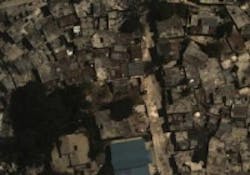Scientists capture Haiti disaster with high-tech imaging system
The LIDAR capability detects and measures collapsed buildings and standing structures damaged by the earthquake. At the request of the U.S. Geological Survey, Faulring is using LIDAR to map the fault line to estimate how much the earth moved. This information is critical to refinement of earthquake-risk prediction models.
"This has been a huge team effort between RIT and a host of collaborators," says Jan van Aardt, associate professor of imaging science and director of the Laboratory for Imaging Algorithms and Systems at RIT. The laboratory within RIT's Carlson Center for Imaging Science developed the sensor system and is working closely with RIT's Digital Imaging and Remote Sensing group to explore applications. "If it had not been for this close-knit collaboration between the two teams, we never would have pulled this off," van Aardt adds. "Next steps will include collaborative product development to aid the relief effort."
For more information, visit www.sciencedaily.com.
-- Posted by Carrie Meadows, Vision Systems Design

